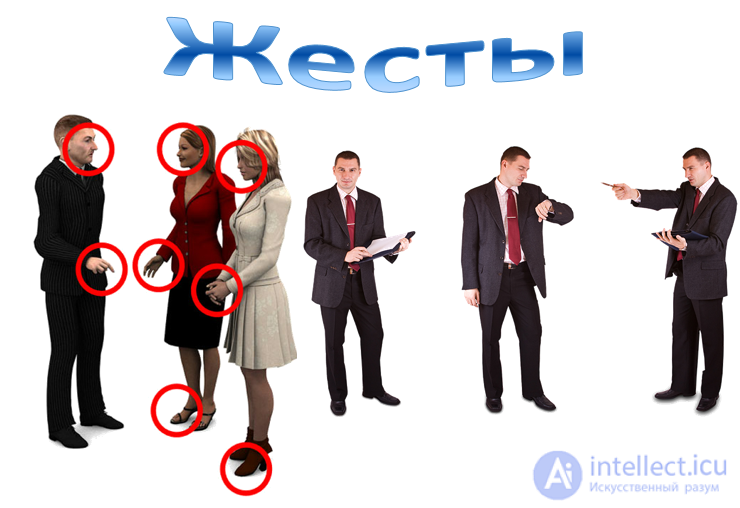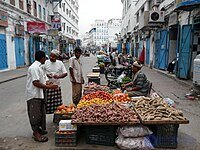Lecture
A gesture (from the Latin gestus “body movement”) is some action or movement of the human body or its part that has a certain meaning or significance, that is, it is a sign or symbol.
Commonly used gestures include actions such as pointing at something or someone (this is one of the few gestures whose meaning varies little across countries), and using the hands and body in sync with the rhythms of speech to emphasize certain words or phrases.
Many similar-looking gestures have different meanings in different countries; the same gesture may be harmless in one country and vulgar in another. In addition, even similar or identical gestures may differ slightly in different countries.
The purpose of studying the issue of sign language is to learn to understand the relationships between people that are expressed in this language, you need to learn to see when your interlocutor is lying, flirting or threatening. This skill can be useful in business, teaching, close relationships and anywhere. The study of sign language began with Charles Darwin's book "The Expression of the Emotions in Man and Animals". Words are used to convey information, and gestures are used to discuss interpersonal relationships. Sign language is inherited by people from their animal ancestors, so a person does not need to be taught to communicate in this language. We make gestures involuntarily, so it is impossible to lie in sign language . You can learn individual simple gestures to deceive your interlocutor, but other small involuntary gestures can give you away completely.
There are three main types of gestures:
Gestures of lying or mistrust are rubbing the eyelid or ear, scratching the neck, pulling the collar, or covering the mouth with a hand. To disguise the last gesture, the liar may pretend to cough or scratch his nose . Open palms mean: "I'm telling the truth." Hands in pockets are a sign of a secretive person . Boredom is expressed by a person propping up his head with his hand .
Gestures of aggression - hands clenched into fists and resting on the hips. Showing thumbs means: "I'm in charge" or "everything is fine" . Hands behind the back or the policeman's gesture means: "I'm not afraid of you" [11] . Arms crossed over the chest mean protection . A slouched back means an inferiority complex. Sitting astride a chair, with the back of the chair in front, means protection . A V-shaped sign with the fingers, when the hand is turned with the palm towards the interlocutor, has an offensive meaning - "shut up". When the hand is turned with the back to the interlocutor - "victory" . A long, fixed gaze in places of detention, combined with narrow pupils (a "snake" look), means anger.

Heinrich Hans Schlimarski "Coquette" (1913)
Flirting gestures in women include a hip gait, showing an open palm, dilated pupils (pool eyes) , which indicate excitement, and a long, intense gaze lasting longer than 10 seconds. The woman begins to “preen her feathers” — preen herself in front of the mirror in front of the man, fix her hair, and put on lipstick . A provocative flirting gesture in men is putting their thumbs in their pockets or belt, which means: “I am a man. I have power over you” [17] . A man can also “preen his feathers” — shake off non-existent dust particles, straighten his tie .
Not only animals, but also humans have their own protective zones and territories that they are ready to protect . Humans have four zones:
In order not to provoke aggression from the interlocutor, it is necessary to keep a distance . The size of the personal spatial zone is determined by national traditions, for example, the Japanese are accustomed to overcrowding and have a smaller personal zone than Americans , so in the case of a conversation between a Japanese and an American, the Japanese will constantly approach the American at an unacceptable distance for the American, as if they were dancing . This is stated on the website https://intellect.icu. Police investigators often use special methods based on penetrating the intimate zone of the criminal during interrogation in order to break the resistance of this criminal .
Aggressiveness of the crowd is a consequence of the crowding of people . The inevitable crowding of people in transport, elevators, and so on leads to the invasion of each other's intimate zones. There are a number of unwritten rules of Western man in these conditions:
Mirroring or repeating the gestures of the interlocutor means agreeing with the opinion of the interlocutor. This technique can be used to achieve mutual understanding with your boss [27] . The turn of the body and legs during the conversation shows the direction of the real interest of your interlocutor, for example, towards an attractive woman, or towards the exit from the room, in these cases you need to end the conversation in time [28] . The arrangement of the interlocutors at the table says a lot. Friends sit across the corner of the table in case of a casual conversation. Close friends or co-authors sit next to each other at the table. Rivals sit opposite each other at the table. People who do not want to interact sit diagonally across the table .

EMBLEMS ILLUSTRATORS ADAPTERS REGULATORS AFFETORS MICROGESTURES

Shaking hands is a relic of primitive society, when people would extend their hands palms forward when meeting to show that they were unarmed [30] . There are different types of handshake:
Gestures (sign language) are a form of nonverbal communication. Sign language is a rich way for people to express a wide variety of emotions and meanings, such as insults, hostility, friendliness, or approval of others. Most people use gestures and body language in addition to words when speaking. Many gestures are used subconsciously by people. Some ethnic groups are thought to use gestures more than others, and the culturally acceptable amount of gesturing varies from place to place. For example, the same gesture in Germany or Scandinavia may be expressed with just a light movement of the hand, while in Italy or Spain the same gesture may be expressed with a sweeping movement of the entire arm.
Commonly used gestures include actions such as pointing at something or someone (one of the few gestures whose meaning varies little across countries), and using the hands and body in sync with the rhythms of speech to emphasize certain words or phrases. Many seemingly similar gestures have different meanings in different countries. The same gesture may be harmless in one country and vulgar in another. In addition, even similar or identical gestures may vary slightly across countries. For example, when a Russian counts on his fingers, he usually curls his fingers inward into his palm, while a typical American, on the contrary, straightens his fingers when counting.
Today, sign language training is used in training managers, as it allows them to understand the secret intentions of business partners. Women understand sign language better, so it is very difficult for a husband to deceive his wife [34] .
S. N. Parkinson emphasizes that people often gesture while talking on the phone, without thinking that the other person does not see their gestures [35] .

Yemen. The city of El-Mukalla. When bargaining and discussing, the local population uses gestures.
As a rule, the further south you go, the more animatedly people gesticulate, the richer their facial expressions and sign language. In Europe, Italians use the most gestures: for example, they express admiration for female beauty in no less than five ways.
Even among neighboring nations, many gestures have the exact opposite meaning. In Bulgaria, shaking the head means agreement, while nodding means the opposite. Similar behavior is also typical of Greeks, Romanians, Macedonians, and Hindus.
In the West, fingers spread out in the shape of the Latin letter V mean victory (Latin: victoria). But before World War II, fingers spread out in the shape of the Latin V, raised above the interlocutor, meant a call to silence. In Italy, it is an offensive hint at adultery. In Russia, it is a "goat", that is, an expression of threat in a marginal environment.
Different nations also say goodbye in different ways: Russians raise their hand, turning the palm away from them and bending it forward and backward. In Italy, they do the same, but turn the palm towards them. The English very slowly move their palm from side to side, and expressive Latin Americans, when saying goodbye (as well as hello), hug and pat each other on the back.
Maltese people signify denial by touching their chin with their fingertips, turning their hand forward. The Japanese in this case shake their palms from side to side, and Arabs throw their heads back.
A Frenchman, finding some idea stupid, taps himself on the head, and a German slaps his forehead with his palm. An Englishman shows with the same gesture that he is pleased with himself. When a Dutchman taps himself on the forehead and extends his index finger upwards, it means that he has appreciated the intelligence of his interlocutor. But if the finger is pointed to the side, it means that the interlocutor is not all there.
To warn that information is secret, Russians and Germans put their finger to their lips, the British to their nose, and in Italy the same gesture serves as a warning of danger.
In English-speaking countries, a ring of thumb and index finger means "everything is fine." However, in Japan, this gesture means a request to lend money, in Brazil, sexual desire, and in France, a distrustful attitude toward the words of the interlocutor. In Turkey and Greece, this gesture can be perceived as a hint at the interlocutor's homosexuality.
A raised thumb, which is a sign of approval for many people, can be painful for Arabs. The Japanese do not welcome handshakes and especially pats on the shoulder; for them, touching the interlocutor during a conversation is an unacceptable liberty.
In Portugal, the gesture of two index fingers placed on the forehead is equivalent to the insult "horned" and means that the interlocutor's wife is cheating on him. This gesture is considered a strong insult, in particular, it was the reason for the resignation of the Minister of Economy of Portugal Manuel Pinho in July 2009. During a debate in the Portuguese parliament, the minister showed "horns" to his opponent from the Communist Party. The offensive gesture caused indignation among parliamentarians, as a result of which the minister was forced to resign, and the prime minister made a public apology for his former colleague [36] .
In China, a common gesture is to make a fist with one hand and the other hand clasping it, with both hands in front of the chest. It means greeting, congratulations, or farewell. There is a special word for this gesture in Chinese: "baoquan" (Chinese simplified:抱拳, pinyin: bàoquán ) [37] .





















Comments
To leave a comment
Kinesika
Terms: Kinesika